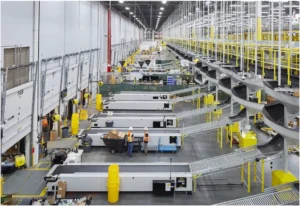Automated conveyor systems are the backbone of many industries, moving materials efficiently through warehouses, production facilities, and industrial sites. At Prairie Electric, we design, program, and integrate these systems with custom electrical solutions tailored to each client. To understand how conveyors support modern automation, it helps to know the six main types: MDR, belt conveyors, screw conveyors, chain conveyors, vibrating conveyors, and pneumatic conveyors.
Motor Driven Roller Conveyors
Motor Drive Roller (MDR) conveyors use individual motors embedded within rollers to power movement along a conveyor line. Each motorized roller typically powers several passive rollers via belts or chains, creating a modular and energy-efficient system.
Unlike traditional conveyors that rely on centralized motors or chains, MDR conveyors allow for zoned control—enabling precise movement, accumulation, and sorting of items without the need for pneumatic or mechanical clutching systems. Their quiet operation, low energy consumption, and high level of automation make them ideal for modern material handling systems.
Examples:
- Moving packages in distribution centers and e-commerce fulfillment warehouses.
- Supporting automated picking and packing lines with on-demand movement.
- Handling lightweight totes and boxes in pharmaceutical or electronics manufacturing.
Belt Conveyors
Belt conveyors are one of the most common types of conveyors. They use a continuous belt loop, driven by pulleys or motors, to move items from one point to another.
The belt is usually made of rubber, plastic, or fabric, depending on the application. Belt conveyors are highly versatile and can be installed in a horizontal, inclined, or even vertical orientation. They are designed to handle a wide range of materials, from small packaged goods to heavy bulk items.
Examples:
- Warehouses transporting boxes between stations.
- Airports moving luggage through terminals.
- Food processing plants carrying produce along inspection lines.
Screw Conveyors
A screw conveyor, also known as an auger conveyor, uses a rotating helical screw blade to move bulk materials through a trough or tube.
As the screw rotates, material is pushed forward along the enclosure. These conveyors are best suited for controlled, gradual movement of bulk goods. They also work well in confined spaces and can handle materials that might not be suited for a belt conveyor.
Examples:
- Moving grain in agricultural applications.
- Feeding cement or ash into hoppers in construction or manufacturing.
- Transporting food-grade materials like flour or sugar in processing facilities.
Chain Conveyors
Chain conveyors use chains to pull or carry products along a fixed path. The chains are often fitted with slats, plates, or attachments that support the product being transported.
Known for their strength and durability, chain conveyors are designed to move heavy loads and withstand challenging environments. They are ideal for continuous or long-distance applications where belts or screws would wear too quickly.
Examples:
- Automotive assembly lines moving car frames.
- Pallet-handling systems in distribution centers.
- Large-scale manufacturing plants transporting heavy machinery components.
Vibrating Conveyors
Vibrating conveyors use vibration to move materials along a trough or tube. Instead of belts or screws, the shaking motion propels the items forward.
These conveyors excel in moving fragile or sticky materials, as the vibration reduces friction and prevents clogging. They can be designed for horizontal or slight incline movement and are known for gentle handling of materials.
Examples:
- Moving sand, gravel, or minerals in mining operations.
- Handling food items like nuts or chips in a processing line.
- Transporting waste or recyclables in facilities where materials vary in size and texture.
Pneumatic Conveyors
Pneumatic conveyors use air pressure or vacuum systems to transport materials through enclosed pipelines.
Instead of mechanical components like belts or screws, pneumatic systems rely on airflow to move powders, pellets, or granules. They are particularly effective for long-distance or vertical transportation and help maintain a dust-free, clean environment.
Examples:
- Moving plastic pellets in manufacturing facilities.
- Feeding flour or sugar in large-scale bakeries.
- Transferring powders in pharmaceutical production.
At Prairie Electric, we build the electrical, programming, and automation systems that make conveyors work seamlessly. From design-build planning to UL-listed control panels, we integrate conveyor systems into broader automation solutions, including robotic arms, packaging equipment, and data systems.
Contact us today to learn more about our automated conveyor solutions and how we can help power your operations. And yes, we provide electrical services in Vancouver, WA while providing industrial solutions throughout the Pacific Northwest.


